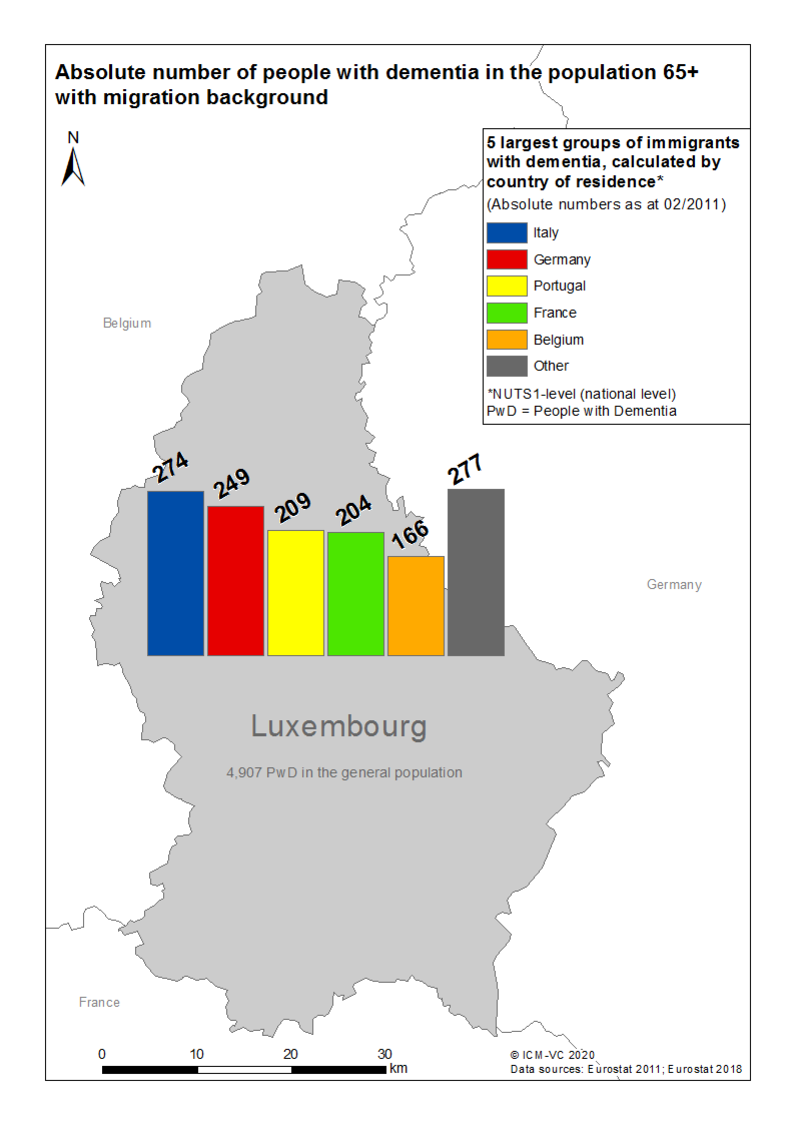EU-Atlas: Dementia & Migration
| Largest group | 2. largest group | 3. largest group | 4. largest group | 5. largest group | |
| Absolute numbers | |||||
| PwMD per 100,000 inhabitants 65+ |
| Absolute numbers | PwMD per 100,000 inhabitants 65+ | |
| Largest group | ||
| 2. largest group | ||
| 3. largest group | ||
| 4. largest group | ||
| 5. largest group |
| Prevalence per 100,000 inhabitants 65+*, calculated by country of residence | |||
|---|---|---|---|
| high > PwMD |
minor > - PwMD |
||
| increased > - PwMD |
low ≤ PwMD | ||
| medium > - PwMD |
|||
| PwMD = People with a Migration background with Dementia *Bulgarien, Litauen, Malta, Polen in der Bevölkerung 60+ |
|||
| Absolute number of PwMD 65+ | |
| PwMD per 100,000 inhabitants 65+ |
Luxembourg
Throughout the 20th century, Luxembourg became a country of immigration, which is historically and currently dominated by flows from other European countries. It started with a large number of foreign workers coming to Luxembourg due to the discovery of iron mineral deposits. From the mid-1980s onwards, immigration to Luxembourg increased significantly1. At the beginning of the 1990s, Luxembourg accepted over 2,000 asylum seekers and after the Kosovo war, most immigrants came from other EU countries2,3. Luxembourg's migrant population (born abroad) more than doubled between 1990 and 2019 (113,800 to 291,700). At the same time, the proportion of migrants in the total population has also risen significantly (from 29.8 to 47.4%)4.
There are 20,000 people with a migration background aged 65 or older. Of those, approx. 1,400 are estimated to exhibit some form of dementia. Calculations show the most affected migrant groups presumably originate from Italy (approx. 300), Germany (approx. 300), Portugal (approx. 200), France (approx. 200), and Belgium (approx. 200)5.
The national action plan on dementia from 2013 addresses several topics, such as quality of life, prevention, care needs of families, or home care. However, it does not refer at any point to migration6. The guideline ‘People With Dementia in Hospital’ from 2018 consists of 40 pages and discusses topics such as admission to hospital or rehabilitation facility, accompaniment by relatives and/or healthcare professionals, or specific training for all persons involved in the care. People with a migration background or aspects related to migration do not receive special attention7.
The healthcare strategy in Luxembourg is an integrative one. Early migrant groups are fully integrated in Luxembourg culture and also almost fully integrated into the healthcare system, but migrants with dementia are not included to this extent. Newer migrant groups are not integrated into the healthcare system, although the healthcare services and service providers try to include migrants and adapt to the needs of this population. Information about dementia as well as inpatient and outpatient care services are available for migrants with dementia. Furthermore, measures to ensure interculturally sensitive care are nationwide in development.
Intercultural care does not seem to be a part of the professional qualification of healthcare professionals on a national scale. There are training and learning opportunities about intercultural care but they are provided on an individual basis. The proportion of professional caregivers who were born in another country working in healthcare is low. But, there is a large proportion of people with a migration background from the second generation working in healthcare.
Families and religious communities play a crucial role in supporting family caregivers with a migration background while migrant organisations play only a moderately important role. Healthcare service providers are important for the integrated migrant groups but not so much for newer migrant groups. The need for specialised information and healthcare services is low.
References
- Beine M, Souy B: The evolution of immigration and asylum policy in Luxembourg: insights from IMPALA. In. Luxembourg: University of Luxembourg; 2016.
- Kollwelter S: Immigration in Luxembourg: new Challenges for an Old Country. [https://www.migrationpolicy.org/article/immigration-luxembourg-new-challenges-old-country]. (2007). Accessed 27 Mar 2020.
- Le Gouvernment Du Grand-Duché de Luxembourg: International Migration in Luxembourg. In: Continuous Reporting System on Migration - OECD. Ministére de la Famille, de I'accuell et de I'Intégration, ; 2018.
- International Organization for Migration: Net migration rate in the next 5 years prior to 2020: Luxembourg; 2019.
- Eurostat: Census 2011; 2011.
- Le Gouvernment Du Grand-Duché de Luxembourg: Demenz: Rapport final du Comité de pilotage en vue de l’établissement d’un plan d’action national «maladies démentielles». In. Edited by Ministére de la Famille et de I'ntegration, Ministére de la Santé; 2013.
- Le Gouvernment Du Grand-Duché de Luxembourg: Menschen mit Demenz im Krankenhaus: Vorschläge für Akutkrankenhäuser und Rehabilitationseinrichtungen für die Betreuung und das Verständnis von Menschen mit Demenz im Krankenhaus. In. Edited by Ministeré de la Santé. Luxembourg; 2018.


![[Translate to Englisch:] Logo RBS [Translate to Englisch:] Logo RBS](/fileadmin/_processed_/9/7/csm_RBS_Logo_RGB_0e245a98a4.jpeg)